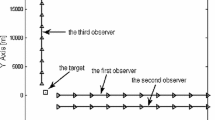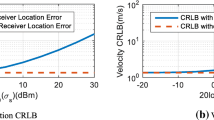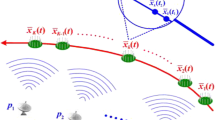Abstract
The direct position determination (DPD) method based on Doppler frequency shifts for signals with known waveforms is first proposed by Amar and Weiss. Although this method exhibits excellent asymptotic performance, but does not account for the effects of uncertainties in the receiver positions and velocities. These uncertainties may result in a considerable reduction of localization accuracy. In this paper, the statistical performance of the DPD estimator is investigated under receiver position and velocity errors (also called model errors). We derive an analytical expression for the mean square error in the estimated source location in the case where the estimator assumes that the receiver positions and velocities are accurate, but they in fact contain errors. The main difficulty in the mathematical analysis is that the DPD cost function is not explicit with respect to the emitter position. Consequently, some algebraic manipulation is required to derive closed-form expressions for the first- and second-order partial derivatives of the cost function. The Cramér–Rao bounds (CRBs) for the target position estimation are also deduced in the presence and absence of model errors. These CRBs provide insights into the effects of model errors on the localization accuracy. Two improved DPD methods are developed based on our analysis results. The first has lower complexity than the common grid search, and the second exhibits increased robustness to model errors. Simulation results support and corroborate the theoretical developments in this paper.













Similar content being viewed by others
References
Amar, A., & Weiss, A. J. (2006). Direct position determination in the presence of model errors—Known waveforms. Digital Signal Processing, 16(1), 52–83.
Amar, A., & Weiss, A. J. (2007). A decoupled algorithm for geolocation of multiple emitters. Signal Processing, 87(10), 2348–2359.
Amar, A., & Weiss, A. J. (2008). Localization of narrowband radio emitters based on Doppler frequency shifts. IEEE Transactions on Signal Processing, 56(11), 5500–5508.
Bao, Q. M., Ko, C. C., & Zhi, W. J. (2005). DOA estimation under unknown mutual coupling and multipath. IEEE Transactions on Aerospace and Electronic Systems, 41(2), 565–573.
Bar-Shalom, O., & Weiss, A. J. (2009). Efficient direct position determination of orthogonal frequency division multiplexing signals. IET Radar, Sonar and Navigation, 3(2), 101–111.
Beck, A., Stoica, P., & Li, J. (2008). Exact and approximate solutions of source localization problems. IEEE Transactions on Signal Processing, 56(5), 1770–1778.
Cheung, K. W., So, H. C., Ma, W. K., & Chan, Y. T. (2004). Least squares algorithms for time-of-arrival-based mobile location. IEEE Transactions on Signal Processing, 52(4), 1121–1128.
Ding, W., & Ying, W. (2017). Statistical performance analysis of direct position determination method based on doppler shifts in presence of model errors. Multidimensional Systems and Signal Processing, 28(1), 149–182.
Friedlander, B., & Weiss, A. J. (1991). Direction finding in the presence of mutual coupling. IEEE Transactions Antennas and Propagation, 39(3), 273–284.
Fu, Z. J., Ren, K., Shu, J. G., Sun, X. M., & Huang, F. X. (2016). Enabling personalized search over encrypted outsourced data with efficiency improvement. IEEE Transactions on Parallel and Distributed Systems, 27(9), 2546–2559.
Gogineni, S., & Nehorai, A. (2011). Target estimation using sparse modeling for distributed MIMO radar. IEEE Transactions on Signal Processing, 59(11), 5315–5325.
Gu, J. F., Wei, P., & Tai, H. M. (2008). Fast direction-of-arrival estimation with known waveforms and linear operators. IET Signal Processing, 2(1), 27–36.
Ho, K. C., Lu, X., & Kovavisaruch, L. (2007). Source localization using TDOA and FDOA measurements in the presence of receiver location errors: Analysis and solution. IEEE Transactions on Signal Processing, 55(2), 684–696.
Ho, K. C., & Sun, M. (2008). Passive source localization using time differences of arrival and gain ratios of arrival. IEEE Transactions on Signal Processing, 56(2), 464–477.
Ho, K. C., & Yang, L. (2008). On the use of a calibration emitter for source localization in the presence of sensor position uncertainty. IEEE Transactions on Signal Processing, 56(12), 5758–5772.
Kutluyil, D. (2005). Bearings-only target localization using total least squares. Signal Processing, 85(9), 1695–1710.
Li, J., Halder, B., Stoica, P., & Viberg, M. (1995). Computationally efficient angle estimation for signals with known waveforms. IEEE Transactions on Signal Processing, 43(9), 2154–2163.
Li, J. Z., Yang, L., Guo, F. C., & Jiang, W. L. (2016). Coherent summation of multiple short-time signals for direct positioning of a wideband source based on delay and Doppler. Digital Signal Processing, 48(1), 58–70.
Mason, J. (2004). Algebraic two-satellite TOA/FOA position solution on an ellipsoidal earth. IEEE Transactions on Aerospace and Electronic Systems, 40(7), 1087–1092.
Nguyen, N. H., & Dogancay, K. (2015). Optimal sensor placement for Doppler shift target localization. In Proceeding of the IEEE radar conference. Arlington, USA: IEEE Press, pp. 1677–1682.
Nguyen, N. H., & Dogancay, K. (2015). Optimal sensor-target geometries for Doppler-shift target localization. In Proceeding of the European signal processing conference. Nice, France: IEEE Press, pp. 180–184.
Oispuu, M., & Nickel, U. (2010). Direct detection and position determination of multiple sources with intermittent emission. Signal Processing, 90(12), 3056–3064.
Pesavento, M., Gershman, A. B., & Wong, K. M. (2002). Direction finding in partly-calibrated sensor arrays composed of multiple subarrays. IEEE Transactions on Signal Processing, 55(9), 2103–2115.
Pourhomayoun, M., & Fowler, M. L. (2014). Distributed computation for direct position determination emitter location. IEEE Transactions on Aerospace and Electronic Systems, 50(4), 2878–2889.
Pulford, G. W. (2010). Analysis of a nonlinear least square procedure used in global positioning systems. IEEE Transactions on Signal Processing, 58(9), 4526–4534.
Rahman, M. Z., & Kleeman, L. (2009). Paired measurement localization: A robust approach for wireless localization. IEEE Transactions on Mobile Computing, 8(8), 1087–1102.
Reuven, A. M., & Weiss, A. J. (2009). Direct position determination of cyclostationary signals. Signal Processing, 89(12), 2448–2464.
Roy, R., & Kailath, T. (1989). ESPRIT-estimation of signal parameters via rotational invariance techniques. IEEE Transactions on Acoustics, Speech, and Signal Processing, 37(7), 984–995.
Schmidt, R. O. (1986). Multiple emitter location and signal parameter estimation. IEEE Transactions on Antennas and Propagation, 34(3), 267–280.
Shen, J., Shen, J., Chen, X. F., Huang, X. Y., & Susilo, W. (2017). An efficient public auditing protocol with novel dynamic structure for cloud data. IEEE Transactions on Information Forensics and Security, 12(10), 2402–2415.
Shen, Y., & Win, M. Z. (2010). Fundamental limits of wideband localization-Part I: A general framework. IEEE Transactions on Information Theory, 56(10), 4956–4980.
Stein, S. (1993). Differential delay/doppler ML estimation with unknown signals. IEEE Transactions on Signal Processing, 41(8), 2717–2719.
Stoica, P., & Larsson, E. G. (2001). Comments on “Linearization method for finding Cramér–Rao bounds in signal processing”. IEEE Transactions on Signal Processing, 49(12), 3168–3169.
Sun, Y. J., & Gu, F. H. (2017). Compressive sensing of piezoelectric sensor response signal for phased array structural health monitoring. International Journal of Sensor Networks, 23(4), 258–264.
Sun, M., & Ho, K. C. (2011). An asymptotically efficient estimator for TDOA and FDOA positioning of multiple disjoint sources in the presence of sensor location uncertainties. IEEE Transactions on Signal Processing, 59(7), 3434–3440.
Viberg, M., & Swindlehurst, A. L. (1994). A Bayesian approach to auto-calibration for parametric array signal processing. IEEE Transactions on Signal Processing, 42(12), 3495–3507.
Wang, Ding, & Ying, Wu. (2015). Sensor array calibration method in presence of gain/phase uncertainties and position perturbations using the spatial- and time-domain information of the auxiliary sources. Multidimensional Systems and Signal Processing, 26(3), 835–868.
Wax, M., & Kailath, T. (1985). Decentralized processing in sensor arrays. IEEE Transactions on Signal Processing, 33(4), 1123–1129.
Weiss, A. J. (2004). Direct position determination of narrowband radio frequency transmitters. IEEE Signal Processing Letters, 11(5), 513–516.
Weiss, A. J. (2011). Direct geolocation of wideband emitters based on delay and Doppler. IEEE Transactions on Signal Processing, 59(6), 2513–5520.
Weiss, A. J., & Amar, A. (2005). Direct position determination of multiple radio signals. EURASIP Journal on Applied Signal Processing, 2005(1), 37–49.
Yang, L., & Ho, K. C. (2009). An approximately efficient TDOA localization algorithm in closed-form for locating multiple disjoint sources with erroneous sensor positions. IEEE Transactions on Signal Processing, 57(12), 4598–4615.
Zhang, Y. H., Sun, X. M., & Wang, B. W. (2016). Efficient algorithm for K-barrier coverage based on integer linear programming. China Communications, 13(7), 16–23.
Zheng, J., & Wu, Y. C. (2010). Joint time synchronization and localization of an unknown node in wireless sensor networks. IEEE Transactions on Signal Processing, 58(3), 1309–1320.
Acknowledgements
The authors would like to thank all the anonymous reviewers for their valuable comments and suggestions. The author also acknowledges support from National Natural Science Foundation of China (Grant Nos. 61201381, 61401513 and 61772548), China Postdoctoral Science Foundation (Grant No. 2016M592989), the Self-Topic Foundation of Information Engineering University (Grant No. 2016600701), and the Outstanding Youth Foundation of Information Engineering University (Grant No. 2016603201).
Author information
Authors and Affiliations
Corresponding author
Appendices
Appendix A: Proof of Proposition 1
A second-order Taylor-series expansion of \( \phi ({\hat{\varvec{q}}},{\varvec{\xi}}) \) around \( {\hat{\varvec{q}}} = {\varvec{q}} \) and \( {\varvec{\xi}} = {\varvec{O}}_{M \times 1} \) produces
where
According to the maximum principle, we have
Then, combining (25), (A.1), and (A.4) yields
where the second- and higher-order error terms (i.e., \( o(||{\varvec{\xi}}||_{2}) \)) are neglected. It is straightforward to deduce from the second equality in (A.5) that
which proves Proposition 1.
Appendix B: Proof of Proposition 2
Define \( \varDelta f_{k}^{{({\text{o}})}} ({\varvec{q}},{\varvec{\xi}}_{k}) \) by
Then, it follows from the first equality in (26) that
The partial derivative of \( \phi ({\varvec{q}},{\varvec{\xi}}) \) with respect to \( {\varvec{q}} \) is given by
where
Further, using (B.3) we obtain
where
On the other hand, combining the maximum principle with the definition of \( \varDelta f_{k}^{{({\text{o}})}} ({\varvec{q}},{\varvec{\xi}}_{k}) \) in (B.1) leads to
Taking the derivative with respect to \( {\varvec{q}} \) on both sides of (B.10) yields
which implies
Similarly, taking the derivative with respect to \( {\varvec{\xi}}_{k} \) on both sides of (B.10), we get
which implies
Inserting (B.10) and (B.12) into (B.6) produces
Substituting (B.10), (B.12) and (B.14) into (B.7) yields
Furthermore, note that \( \varDelta f_{k} = \varDelta f_{k}^{{({\text{o}})}} ({\varvec{q}},{\varvec{O}}_{{M_{0} \times 1}}) \). As a consequence, if the error vector \( {\varvec{\xi}} \) in (B.15) and (B.16) is replaced with \( {\varvec{O}}_{M \times 1} \), both (29) and (30) hold. This completes the proof of Proposition 2.
Appendix C: Detailed derivation of \( {\dot{\varvec{C}}}_{k,j}^{(1)} ({\varvec{q}},{\bar{\varvec{p}}}_{k}) \) and \( {\varvec{\ddot{C}}}_{{k,j_{1} j_{2}}}^{(1)} ({\varvec{q}},{\bar{\varvec{p}}}_{k}) \)
It can be easily seen from (16) that
where
Using the first equality in (9), we have
which implies
Next, expressions for the gradient vector and Hessian matrix of \( \gamma ({\varvec{q}},{\bar{\varvec{p}}}_{l,k}) \) with respect to \( {\varvec{q}} \) are derived, which lead to \( \frac{{\partial \gamma ({\varvec{q}},{\bar{\varvec{p}}}_{l,k})}}{{\partial < {\varvec{q}} >_{j}}} \) and \( \frac{{\partial^{2} \gamma ({\varvec{q}},{\bar{\varvec{p}}}_{l,k})}}{{\partial < {\varvec{q}} >_{{j_{1}}} \partial < {\varvec{q}} >_{{j_{2}}}}} \), respectively.
First, it follows from (3) that
which implies
Obviously, \( \frac{{\partial \gamma ({\varvec{q}},{\bar{\varvec{p}}}_{l,k})}}{{\partial < {\varvec{q}} >_{j}}} \) is the jth component of \( \frac{{\partial \gamma ({\varvec{q}},{\bar{\varvec{p}}}_{l,k})}}{{\partial {\varvec{q}}}} \) and \( \frac{{\partial^{2} \gamma ({\varvec{q}},{\bar{\varvec{p}}}_{l,k})}}{{\partial < {\varvec{q}} >_{{j_{1}}} \partial < {\varvec{q}} >_{{j_{2}}}}} \) is the (j1, j2)th element of \( \frac{{\partial^{2} \gamma ({\varvec{q}},{\bar{\varvec{p}}}_{l,k})}}{{\partial {\varvec{q}}\partial {\varvec{q}}^{\text{T}}}} \).
Appendix D: Detailed derivation of \( {\dot{\varvec{C}}}_{k,j}^{(2)} ({\varvec{q}},{\bar{\varvec{p}}}_{k}) \) and \( {\varvec{\ddot{C}}}_{{k,j_{1} j_{2}}}^{(2)} ({\varvec{q}},{\bar{\varvec{p}}}_{k}) \)
Using (16) and the definition of the error vector \( {\varvec{\xi}}_{k} \) yields
where
Furthermore, from (D.1) and the definition of \( {\varvec{\xi}}_{k} \), we have that
where
Similar to the derivation in (C.4) and (C.5), it can be checked that
In the following, we derive expressions for the first-order partial derivative vector \( \frac{{\partial \gamma ({\varvec{q}},{\bar{\varvec{p}}}_{l,k})}}{{\partial {\varvec{q}}}} \) and second-order partial derivative matrix \( \frac{{\partial^{2} \gamma ({\varvec{q}},{\bar{\varvec{p}}}_{l,k})}}{{\partial {\varvec{q}}\partial {\bar{\varvec{p}}}_{l,k}^{\text{T}}}} \).
First, combining (3) and the definition of \( {\bar{\varvec{p}}}_{l,k} \) leads to

which implies

It is evident that \( \frac{{\partial \gamma ({\varvec{q}},{\bar{\varvec{p}}}_{l,k})}}{{\partial < {\bar{\varvec{p}}}_{l,k} >_{j}}} \) is the jth component of \( \frac{{\partial \gamma ({\varvec{q}},{\bar{\varvec{p}}}_{l,k})}}{{\partial {\bar{\varvec{p}}}_{l,k}}} \) and \( \frac{{\partial^{2} \gamma ({\varvec{q}},{\bar{\varvec{p}}}_{l,k})}}{{\partial < {\varvec{q}} >_{{j_{1}}} \partial < {\bar{\varvec{p}}}_{l,k} >_{{j_{2}}}}} \) is the (j1, j2)th entry of \( \frac{{\partial^{2} \gamma ({\varvec{q}},{\bar{\varvec{p}}}_{l,k})}}{{\partial {\varvec{q}}\partial {\bar{\varvec{p}}}_{l,k}^{\text{T}}}} \).
Rights and permissions
About this article
Cite this article
Wang, D., Yin, J., Liu, R. et al. Performance analysis and improvement of direct position determination based on Doppler frequency shifts in presence of model errors: case of known waveforms. Multidim Syst Sign Process 30, 749–790 (2019). https://doi.org/10.1007/s11045-018-0579-z
Received:
Revised:
Accepted:
Published:
Issue Date:
DOI: https://doi.org/10.1007/s11045-018-0579-z




